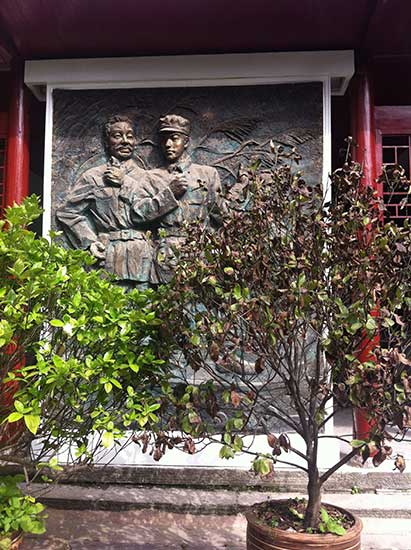Travelers of a hard road
 |
|
The former house of Zhou Yiqun, a Communist patron, is turned into a museum dedicated to the campaign in the same city.[Photo By Yang Jun and Satarupa Bhattacharjya /China Daily] |
He learned surgery in the battlefields from the late Canadian physician Norman Bethune, who was assisting Communist troops in the 1930s in China's northern villages.
At a distance of some 120 kilometers from Tongren is Yinjiang, a county where Meng Shaojin, another veteran of the march, lives. He too was in his teens when a faction of the Red Army that was being led by area commander He Long, visited his village in 1934 to mobilize local support.
Meng, now 95, betrays signs of aging like Huang. Both have heavily pigmented wrinkled skin on their hands and are hard of hearing. But sitting at a restaurant that is by the side of a small river, in a blue shirt and dark trousers, Meng appears more collected in his thoughts while talking about the march.
Along with an older brother, Meng had joined the village militia to help Communist troops. They walked long distances for weeks, with spears in hand to defend against attacks by the KMT or local warlords, occasionally functioning as porters for the troops carrying crops and goods from village to village, his son, Meng Shaoping, says.
In October that year, when the troops were in Lan Bagou, a neighboring village surrounded by hills, they came under fire, Meng Shaojin says.
"The fighting started around noon. We were suddenly attacked by KMT forces from up in the hills," Meng Shaojin says.
Most Communist fighters had swords or spears. A few had the Tao Tong handmade guns, he adds. He was in the vicinity when the bullets started to rain from the other side and was asked by a senior trumpet player of the Red Army to seek cover behind a big rock.
"It was fierce," Meng Shaoping, 65, quotes his father as telling him later.
Many Communist troops were killed and after the fighting was over, the remaining soldiers had dispersed. Meng Shaojin stayed under-ground for months fearing he would be executed by KMT backers if found. Slowly he re-emerged in his village and took up farming. He worked in the county's forest department until 1957.
Among the 300 people from the county who had become guerrilla fighters, 20 were women, he says.
In nearby Yanhe county, 40-year-old Liu Yongpiao, says he is honoring the legacy of his late grandfather, Liu Guofu, a Communist guerrilla during the march, by employing more poor villagers in his honeysuckle and plums business.
Yang Jun and Dong Xianwu contributed to this story.
















